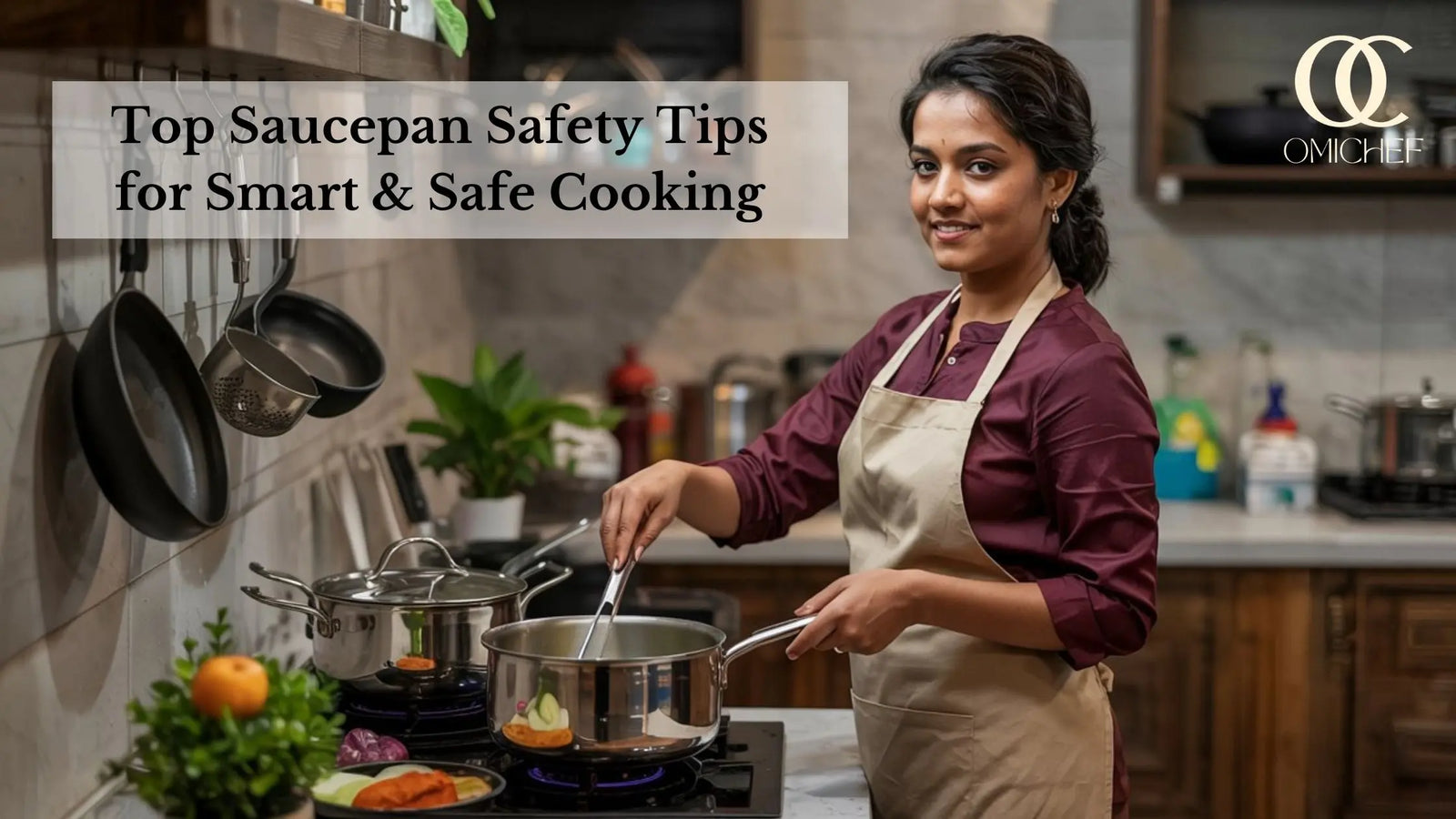Introduction
Whether you are a beginner in the kitchen or a seasoned home cook, following the right saucepan safety tips can protect you from accidents and improve your cooking efficiency. Using stainless steel and Triply saucepans is a smart choice, but it's essential to handle them properly. From common burn hazards to poor grip and uneven heating issues, this blog will walk you through practical solutions to everyday saucepan safety challenges. Let's explore how you can turn cooking into a safe and enjoyable experience.
Check out : Triply Frypan with Lid: Your Kitchen’s Power Tool.

Common Problem #1: Burn Hazards from Overheating
One of the most frequent kitchen incidents is burning yourself by accidentally touching overheated pan handles. Triply and stainless steel saucepans, known for their excellent heat retention, can easily become too hot to handle.
Solution: Always use a dry cloth or silicone grip when holding the handle. If your saucepan doesn’t have a heat-resistant handle, wrap it with a heat-safe cover. Also, avoid leaving your pan unattended on high flame. Use a medium flame to maintain controlled heating—especially when working with Triply cookware, which distributes heat faster and more evenly.
Example: A customer using a Triply Saucepan once shared how she left her dal boiling and returned after five minutes, only to find the handle too hot to grip. A simple addition of a handle cover could have prevented this situation entirely.
Common Problem #2: Boil-Over Spills and Slips
Another kitchen hazard is boil-over, which can lead to spills on stovetops and floors, causing slips and burns. This is especially common when heating milk or boiling water.
Solution: Choose a saucepan with high sidewalls and always keep the lid slightly ajar when boiling liquids. This reduces steam pressure and prevents spills. Triply Saucepan Tips recommend not overfilling the pan and keeping an eye on the liquid level. The Triply build helps maintain a steady boil without rapid surges, minimizing the risk of overflow.
Example: While making tea in a stainless steel saucepan, filling it more than 80% led to an overflow that caused a sticky mess on the stove. Keeping it to two-thirds full and watching the flame would have prevented this problem.
Common Problem #3: Slippery or Unstable Grips
Using a saucepan with wet or greasy handles increases the risk of accidental drops. Many saucepans don’t have ergonomic designs, making them difficult to hold firmly, especially when they are hot or full.
Solution: Opt for stainless steel or Triply saucepans with strong, riveted handles that stay cool or offer a firm grip. Make it a habit to wipe your hands and the handle before lifting. For better balance, use both hands while transferring hot contents.
Example: A home cook once tried lifting a full stainless steel saucepan with one hand while the handle was greasy. The pot slipped, spilling hot soup and causing a minor burn. Holding it with two hands and cleaning the handle could have avoided the mishap.
Common Problem #4: Incompatible Cooktops and Improper Placement
Placing a saucepan that doesn't sit properly on your cooktop, especially on induction or glass surfaces, may cause wobbling and unsafe heat distribution.
Solution: Always use a flat-bottomed saucepan for stable placement. One of the valuable Triply Saucepan Tips is to check for compatibility with your cooktop. Triply and stainless steel pans generally work well with gas, induction, and ceramic surfaces. Ensure the base makes full contact with the burner for even heating and to avoid tipping.
Example: On an induction stove, a user placed a slightly warped aluminum saucepan that kept wobbling. Switching to a flat Triply saucepan provided stability and faster heating without safety concerns.
Common Problem #5: Neglecting Regular Maintenance and Inspection
Over time, loose handles, minor dents, and rust can lead to saucepan failures or accidents. Even durable stainless steel saucepans need care and checks.
Solution: Periodically inspect your saucepan for any structural damage. Tighten screws or rivets on handles if needed. Avoid using abrasive cleaners that can scratch the surface. Follow basic saucepan tips like washing with mild soap and drying thoroughly to prevent rust. Triply cookware is less likely to warp or dent, but it’s still good practice to handle it gently and store it properly.
Example: A customer continued using a saucepan with a loose handle, thinking it wasn't serious. One day, the handle detached while lifting hot curry, leading to a kitchen spill and mild burn. Early maintenance could have prevented this.
Check out : Best Cooker for Health: Cook Smart, Eat Safe Every Day.
 Choose Quality: Why Omichef Triply Saucepan Is the Safer Choice
Choose Quality: Why Omichef Triply Saucepan Is the Safer Choice
When it comes to safety, material and design make all the difference. Omichef's Triply Saucepan is built with three layers—stainless steel inside, aluminum in the middle for even heat distribution, and stainless steel exterior for durability. These pans are not only induction-friendly but also equipped with ergonomically designed handles, spill-resistant edges, and sturdy lids.
Following saucepan safety tips is easier when your cookware supports you. Omichef Triply Saucepan ensures cooking is not just efficient but also secure. Plus, it's dishwasher-safe and resistant to rust and corrosion—ideal for everyday Indian kitchens.
Check out : 10 Safety Tips in the Kitchen for a Secure Cooking Space.
Conclusion: Cook Smart with These Saucepan Tips
Understanding and applying the right saucepan safety tips can save you from kitchen mishaps and make cooking more enjoyable. Whether you are boiling, sautéing, or reheating, safety starts with awareness and the right equipment. From preventing burns and spills to ensuring proper grip and maintenance, every step counts.
Using a stainless steel or Triply Saucepan gives you a head start in safe cooking. Brands like Omichef bring reliability, quality, and thoughtful design into your kitchen. Explore their Triply cookware range on Flipkart or visit the official Omichef store today for safe and smart cooking solutions.
Remember, when it comes to your kitchen, safety is just as important as taste. Stay aware, stay equipped—and happy cooking!

